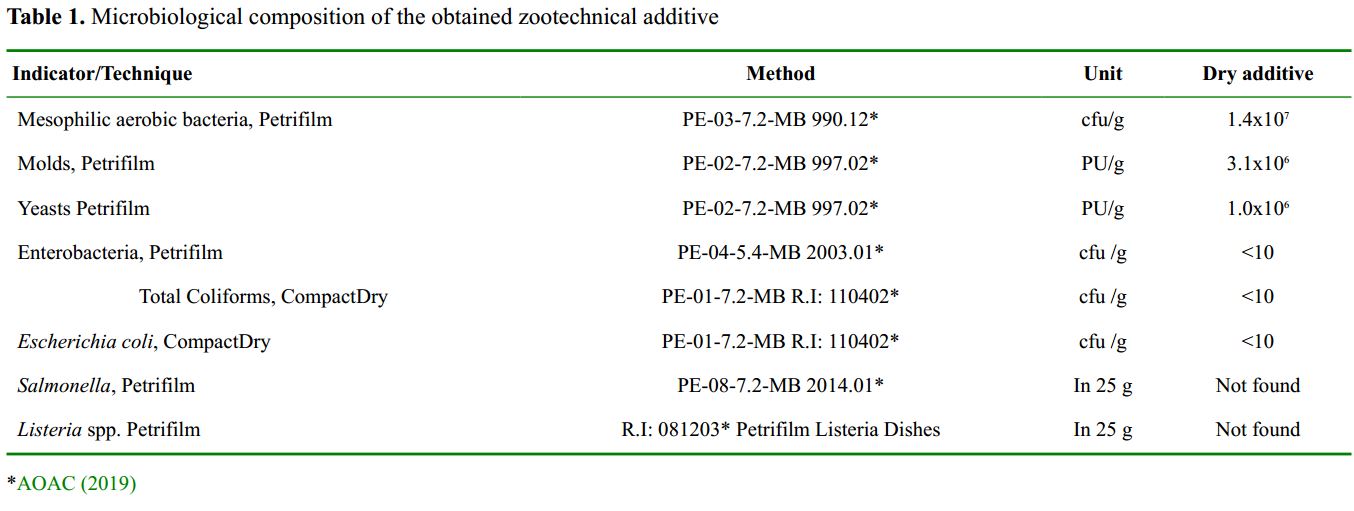Microbiological and chemical characteristics of a zootechnical additive obtained in Ecuador for its use in animal feeding
Main Article Content
Abstract
Microbiological and chemical characteristics of a zootechnical additive were determined for its use in animal feeding. The production process consisted of batch submerged fermentation at 18 ± 2 °C for seven days, mixed with an absorbent material, and then dried naturally. Two batches were formed, and the concentrations of mesophilic aerobes, fungi and yeasts, enterobacteria, total coliforms, Escherichia coli, Salmonella, and Listeria were calculated in duplicate. Humidity percentage, crude protein, ash, fat, crude fiber, total carbohydrates, pH, and total solids were also determined. The solid additive presented 1.4x107 cfu/g of mesophilic aerobes, 106 cfu/g of yeast, absence of pathogens, 14.2 % of humidity, 14 % of protein and crude fiber, 11.8 % of ash, 0.21 % of fat, pH of 6.72, and 3.0° Brix. Results indicate that the product has potential for its use as a zootechnical additive.
Article Details

This work is licensed under a Creative Commons Attribution-NonCommercial 4.0 International License.
Those authors that have publications with this journal accept the following terms:
1. They will retain their copyright and guarantee the journal the right of first publication of their work, which will be simultaneously subject to the License Creative Commons Attribution-NonCommercial 4.0 International (CC BY-NC 4.0) that allows third parties to share the work whenever its author is indicated and its first publication this journal. Under this license the author will be free of:
- Share — copy and redistribute the material in any medium or format
- Adapt — remix, transform, and build upon the material
- The licensor cannot revoke these freedoms as long as you follow the license terms.
Under the following terms:
- Attribution — You must give appropriate credit, provide a link to the license, and indicate if changes were made. You may do so in any reasonable manner, but not in any way that suggests the licensor endorses you or your use.
- NonCommercial — You may not use the material for commercial purposes.
- No additional restrictions — You may not apply legal terms or technological measures that legally restrict others from doing anything the license permits.
2. The authors may adopt other non-exclusive license agreements to distribute the published version of the work (e.g., deposit it in an institutional telematics file or publish it in a monographic volume) whenever the initial publication is indicated in this journal.
3. The authors are allowed and recommended disseminating their work through the Internet (e.g. in institutional telematics archives or on their website) before and during the submission process, which can produce interesting exchanges and increase the citations of the published work. (See the Effect of open access).
References
Anee, I.J., Alam, S., Begum, R.A., Shahjahan, R.Md. & Khandaker, A.M. 2021. The role of probiotics on animal health and nutrition. The Journal of Basic and Applied Zoology, 82: 52, ISSN: 2090-990X. https://doi.org/10.1186/s41936-021-00250-x.
AOAC. 2019. Métodos oficiales de análisis de la Asociación de Químicos Analíticos Oficiales: Métodos oficiales de análisis de la AOAC Internacional. 21.ª edición, AOAC, Washington DC.
Bustamante, D., Savón, L., Elías, A., Caro, Y., Valiño, E.C., Rojas, M., Martin, C. & Mireles, S. 2021. Chemical and microbiological characterization of a technological variant of Vitafert intended for animal production. Technical note. Cuban Journal of Agricultural Science, 55(2): 61-73, ISSN: 2079-3480. http://cjascience.com/index.php/CJAS/article/view/940.
Díaz, B.L., Elías, A. & Valiño, E. 2014. Consorcios microbianos con actividad ácido-láctica promisoria aislados desde inoculantes bacterianos nativos para ensilajes. Ciencia y Agricultura, 11(1): 17-25, ISSN: 2539-0899. https://doi.org/10.19053/01228420.3484.
FAO/WHO (Food and Agriculture Organization of the United Nations/World Health Organization). 2002. Guidelines for the evaluation of probiotics in food. Report of a joint FAO/WHO working group on drafting guidelines for the evaluation of probiotics in food. April 30 and May 1. London Ontario, Canada. Available at: http://www.who.int/foodsafety/fs_manage ment/en/probiotic_guidelines.pdf. [Consulted: October 25, 2016].
Flores-Mancheno, L.F., García-Hernández, Y., Usca-Méndez, J.E. & Caicedo-Quinche, W.O. 2016. Estudio comparativo de tres aditivos zootécnicos en el comportamiento productivo y sanitario de cerdos en el período post-destete. Ciencia y Agricultura, 13(2): 95-105, ISSN: 2539-0899. https://doi.org/10.19053/01228420.v13.n2.2016.5557.
García, Y., Sosa, D., González, L. & Dustet, J.C. 2020. Caracterización química, física y microbiológica de alimentos fermentados para su uso en la producción animal. Livestock Research for Rural Development, 32(7): 105, ISSN: 2521-9952. https://www.lrrd.org/lrrd32/7/Yaneis32105.html.
NTE INEN 522. Norma Técnica Ecuatoriana 522:2013 del Instituto Ecuatoriano de Normalización. Harinas de origen vegetal. Determinación de la fibra cruda. Available at: https://www.normalizacion.gob.ec.
Kholif, A.E., Anele, A. & Anele, U.Y. 2024. Microbial feed additives in ruminant feeding. AIMS Microbiology, 10(3): 542-571, ISSN: 2471-1888. https://doi:10.3934/microbiol.2024026.
Toledo, R.T. 2007. Chapter 12. Dehydration. In: Fundamentals of Food Process Engineering. Third Edition. Springer Science+Business Media, LLC, New York, p. 431-473.
Valiño, E., García, Y., Bustamante, D. & Beruvides, A. 2024. Desarrollo y utilización del Vitafert en el sector agropecuario. Cuban Journal of Agricultural Science, 58: e17, ISSN: 2079-3480. http://cjascience.com/index.php/CJAS/article/view/1153.
